Implementation of a Multi-Zone Numerical Blow-by Model and Its Integration with CFD Simulations for Estimating Collateral Mass and Heat Fluxes in Optical Engines
Abstract
1. Introduction
2. Materials and Methods
2.1. Experimental Test Engine Description
2.2. Blow-by Mathematical Modelling
- A single-phase gaseous system is considered, in particular, in firing conditions it is assumed that the fuel fully evaporates at the start of the injection, thus, the fuel liquid phase is not modeled;
- The fluid is an ideal gas composed of dry air and fuel vapor;
- The flow is one-dimensional along the stroke direction, thus, radial effects are neglected;
- The cross section area of the orifices is constant during the simulation, i.e., the metal linear thermal expansion due to the combustion-induced temperature raising is not considered;
- The simulation is isothermal, in particular, it is assumed that the gases have the same temperature of that of the piston crown.
- three zones called ‘active domains’, which are: the piston top land crevice (zone 2), second land crevice (zone 3), and third land crevice (zone 4);
- two additional zones called ‘ambient domains’, namely the combustion chamber (zone 1) and the crankcase (zone 5), which are used to provide the active zones with the boundary conditions.
2.2.1. Calculation of the Blow-by-Induced Mass Flow
- direct (if positive), describing the occurrence of blow-by-induced mass loss from the zone i towards the zone i + 1, e.g., gas flow from the combustion chamber towards the piston top land crevice;
- inverse (if negative), describing the occurrence of blow-by-induced mass recover in the zone i from the zone i + 1, e.g., gas backflow from the piston top land crevice to the combustion chamber.
2.2.2. Mass Flow-Induced Crevice Pressure Variation Calculation
2.2.3. Post-Processing of the Numerical Solution
2.2.4. Calculation of the Blow-by-Induced Cylinder Net Pressure
2.3. CFD Simulation Methodology
3. Results
3.1. Stand-Alone Configuration: Model Validation
3.2. Stand-Alone Mode: Simulation of New Points
3.2.1. Effect of the Piston Temperature
3.2.2. Effect of the Engine Speed
3.2.3. Effect of the Charge Dilution
3.3. Combined Configuration: Model Validation
4. Discussion
Author Contributions
Funding
Institutional Review Board Statement
Informed Consent Statement
Data Availability Statement
Conflicts of Interest
Appendix A
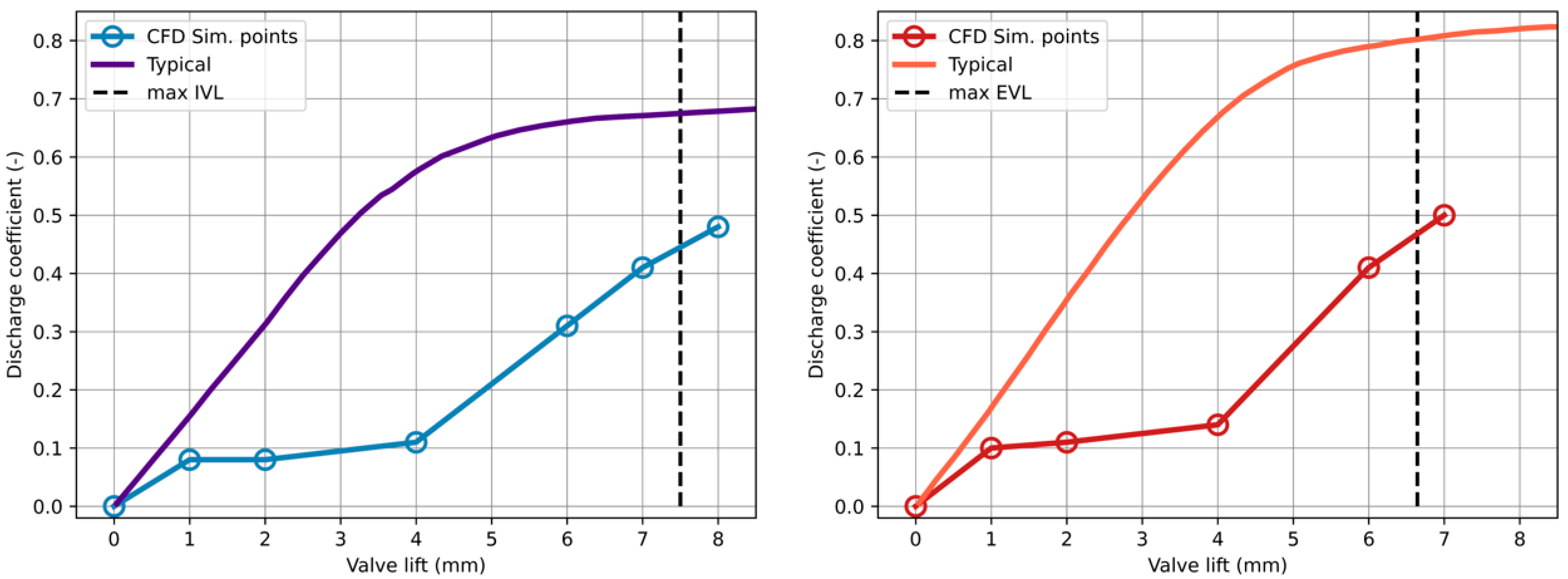

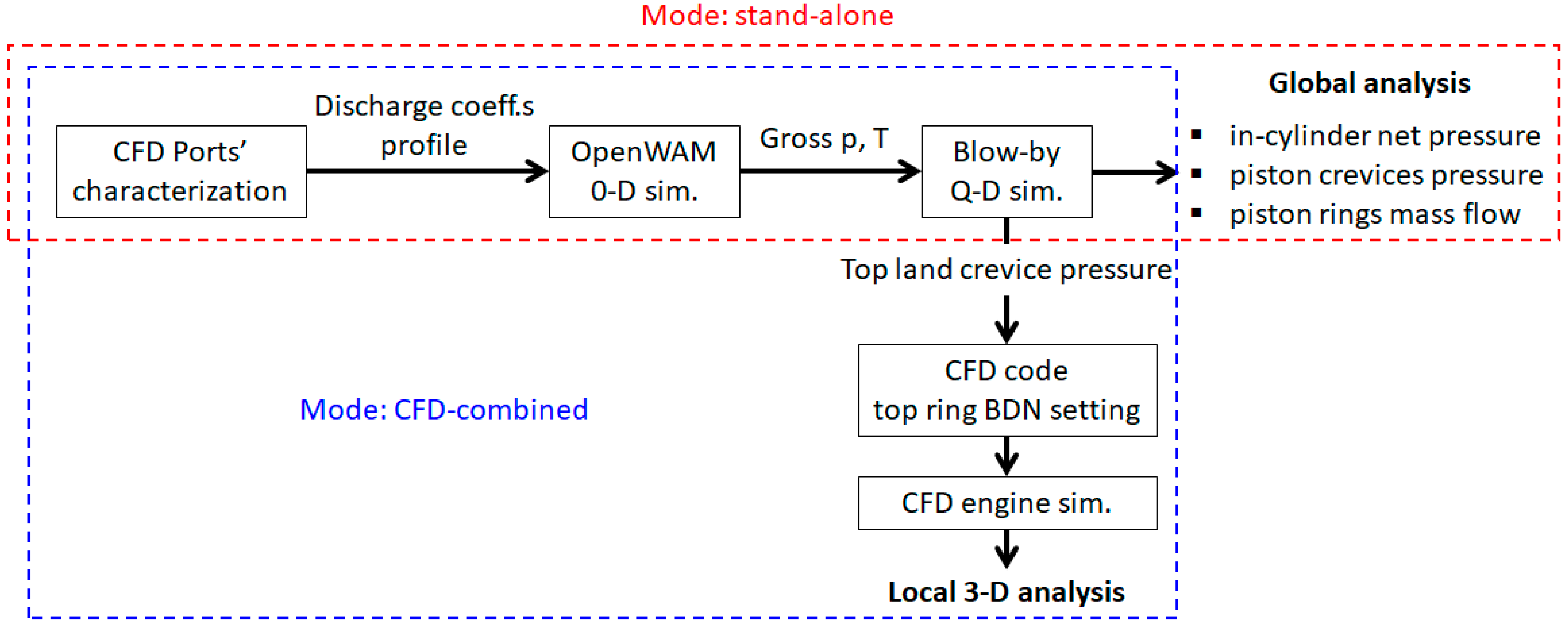
References
- Robertson, D.; Prucka, R. A Review of Spark-Assisted Compression Ignition (SACI) Research in the Context of Realizing Production Control Strategies. SAE Tech. Pap. 2019. [Google Scholar] [CrossRef]
- Polovina, D.; McKenna, D.; Wheeler, J.; Sterniak, J.; Miersch-Wiemers, O.; Mond, A.; Yilmaz, H. Steady-State Combustion Development of a Downsized Multi-Cylinder Engine with Range Extended HCCI/SACI Capability. SAE Int. J. Engines 2013, 6, 504–519. [Google Scholar] [CrossRef]
- Temel, V.K.; Sterniak, J. Characterization of SACI Combustion for Use in Model Based Controls. SAE Tech. Pap. 2014. [Google Scholar] [CrossRef]
- Aengeby, J. Closed Loop Control of the Combustion Phase in SI Engines Using Alternative Fuels. SAE Int. J. Adv. Curr. Pract. Mobil. 2020, 3, 312–319. [Google Scholar] [CrossRef]
- Overbrueggen, T.V.; Braun, M.; Klaas, M.; Schroder, W. Experimental Analysis of the Impact of Injected Biofuels on In-Cylinder Flow Structures. SAE Int J. Engines 2016, 9, 1320–1348. [Google Scholar] [CrossRef]
- Barroso, P.M.; Ribas, X.; Pita Sr, M.; Dominguez, J.; De Seia, E. HD Diesel Engines Development for Alternative Fuel Use. SAE Int J. Engines 2015, 8, 326–340. [Google Scholar] [CrossRef]
- Masuda, T. Experiment on the Rate of Blow-by in a Spark Ignition Engine. Bull. JSME 1960, 3, 104–111. [Google Scholar] [CrossRef][Green Version]
- Aghdam, E.A.; Kabir, M.M. Validation of a blowby model using experimental results in motoring condition with the change of compression ratio and engine speed. Exp. Therm. Fluid Sci. 2010, 34, 197–209. [Google Scholar] [CrossRef]
- Mahmud, Z.A. End Gas Autoignition and Knock in Spark Ignition Engines. Ph.D. Thesis, University of Leeds, Leeds, UK, 1999. [Google Scholar]
- Cairn, A. Turbulent Flame Development in a Spark Ignition Engine. Ph.D. Thesis, University of Leeds, Leeds, UK, 2001. [Google Scholar]
- Namazian, M.; Heywood, J. Flow in the Piston-Cylinder-Ring Crevices of a Spark-Ignition Engine: Effect on Hydrocarbon Emissions, Efficiency and Power; SAE Technical Paper 820088; SAE International: Warrendale, PA, USA, 1982. [Google Scholar]
- Kuo, T.; Sellnau, M.; Theobald, M.; Jones, J. Calculation of Flow in the Piston-Cylinder-Ring Crevices of a Homogeneous-Charge Engine and Comparison with Experiment. SAE Trans. 1989, 98, 1469–1482. [Google Scholar]
- Malagi, R.R. Estimation of Blowby in Multi-cylinder Diesel Engine Using Finite Element Approach. SAE Tech. Pap. 2012. [Google Scholar] [CrossRef]
- Irimescu, A.; Di Iorio, S.; Merola, S.S.; Sementa, P.; Vaglieco, B.M. Evaluation of compression ratio and blow-by rated for spark ignition engines based on in-cylinder pressure trace analysis. Energy Convers. Manag. 2018, 162, 98–108. [Google Scholar] [CrossRef]
- Irimescu, A.; Tornatore, C.; Marchitto, L.; Merola, S.S. Compression ratio and blow-by rates estimation based on motored pressure trace analysis for an optical spark ignition engine. Appl. Therm. Eng. 2013, 61, 101–109. [Google Scholar] [CrossRef]
- Breda, S.; D’Orrico, F.; Berni, F.; d’Adamo, A.; Fontanesi, S.; Irimescu, A.; Merola, S.S. Experimental and numerical study on the adoption of split injection strategies to improve air-butanol mixture formation in a DISI optical engine. Fuel 2019, 243, 104–124. [Google Scholar] [CrossRef]
- Merola, S.S.; Irimescu, A.; Vaglieco, B.M. Influence of water injection on combustion identified through spectroscopy in an optical direct injection spark ignition engine. Fuel 2020, 273, 117729. [Google Scholar] [CrossRef]
- Irimescu, A.; Marchitto, L.; Merola, S.S.; Tornatore, C.; Valentino, G. Evaluation of different methods for combined thermodynamic and optical analysis of combustion in spark ignition engines. Energy Convers. Manag. 2014, 87, 914–927. [Google Scholar] [CrossRef]
- Merola, S.S.; Irimescu, A.; Marchitto, L.; Tornatore, C.; Valentino, G. Effect of injection timing on combustion and soot formation in a direct injection spark ignition engine fueled with butanol. Int. J. Engine Res. 2017, 18, 490–504. [Google Scholar] [CrossRef]
- Irimescu, A.; Merola, S.S.; Tornatore, C.; Valentino, G. Development of a semi-empirical convective heat transfer correlation based on thermodynamic and optical measurements in a spark ignition engine. Appl. Energy 2015, 157, 777–788. [Google Scholar] [CrossRef]
- Bowditch, F. A New Tool for Combustion Research A Quartz Piston Engine. SAE Tech. Pap. 1961. [Google Scholar] [CrossRef]
- Heywood, J.B. Internal Combustion Engine Fundamentals; McGraw-Hill Education: New York, NY, USA, 1988; p. 226. [Google Scholar]
- Green, D.W.; Southard, M.Z. Perry’s Chemical Engineers’ Handbook, 9th ed.; McGraw-Hill Education: New York, NY, USA, 2018. [Google Scholar]
- Baker, R.G. Flow Measurement Handbook: Industrial Designs, Operating Principles, Performance, and Applications; Cambridge University Press: Cambridge, UK, 2000. [Google Scholar]
- Brahma, I. Measurement and Prediction of Discharge Coefficients in Highly Compressible Pulsating Flows to Improve EGR Flow Estimation and Modeling of Engine Flows. Front. Mech. Eng. 2019, 5, 25. [Google Scholar] [CrossRef]
- OpenWAM. Available online: http://openwam.webs.upv.es/docs/ (accessed on 3 December 2021).
- Sadeghi, M.; Behnia, F. Otpimum window length of Savitzky-Golay filters with arbitrary order. arXiv 2018, arXiv:1808.10489. [Google Scholar]
- Brusiani, F.; Bianchi, G.M.; Tiberi, A. Primary Breakup Model for Turbulent Liquid Jet Based on Ligament Evolution. SAE Tech. Pap. 2012. [Google Scholar] [CrossRef]
- Pulga, L.; Bianchi, G.M.; Ricci, M.; Cazzoli, G. Development of a Novel Machine Learning Methodology for the Generation of a Gasoline Surrogate Laminar Flame Speed Database under Water Injection Engine Conditions. SAE Int. J. Fuels Lubr. 2019, 13, 5–17. [Google Scholar] [CrossRef]
- Marchitto, L.; Merola, S.; Tornatore, C.; Valentino, G. Experimental Study on the Spray Atomization of a Multi-hole Injector for Spark Ignition Engines Fuelled by Gasoline and n-Butanol. SAE Tech. Pap. 2014. [Google Scholar] [CrossRef]
- Marchitto, L.; Valentino, G.; Merola, S.; Tornatore, C. Characterization of Alcohol Sprays from Multi-hole Injector for DISI Engines through PIV Technique. SAE Tech. Pap. 2015. [Google Scholar] [CrossRef]
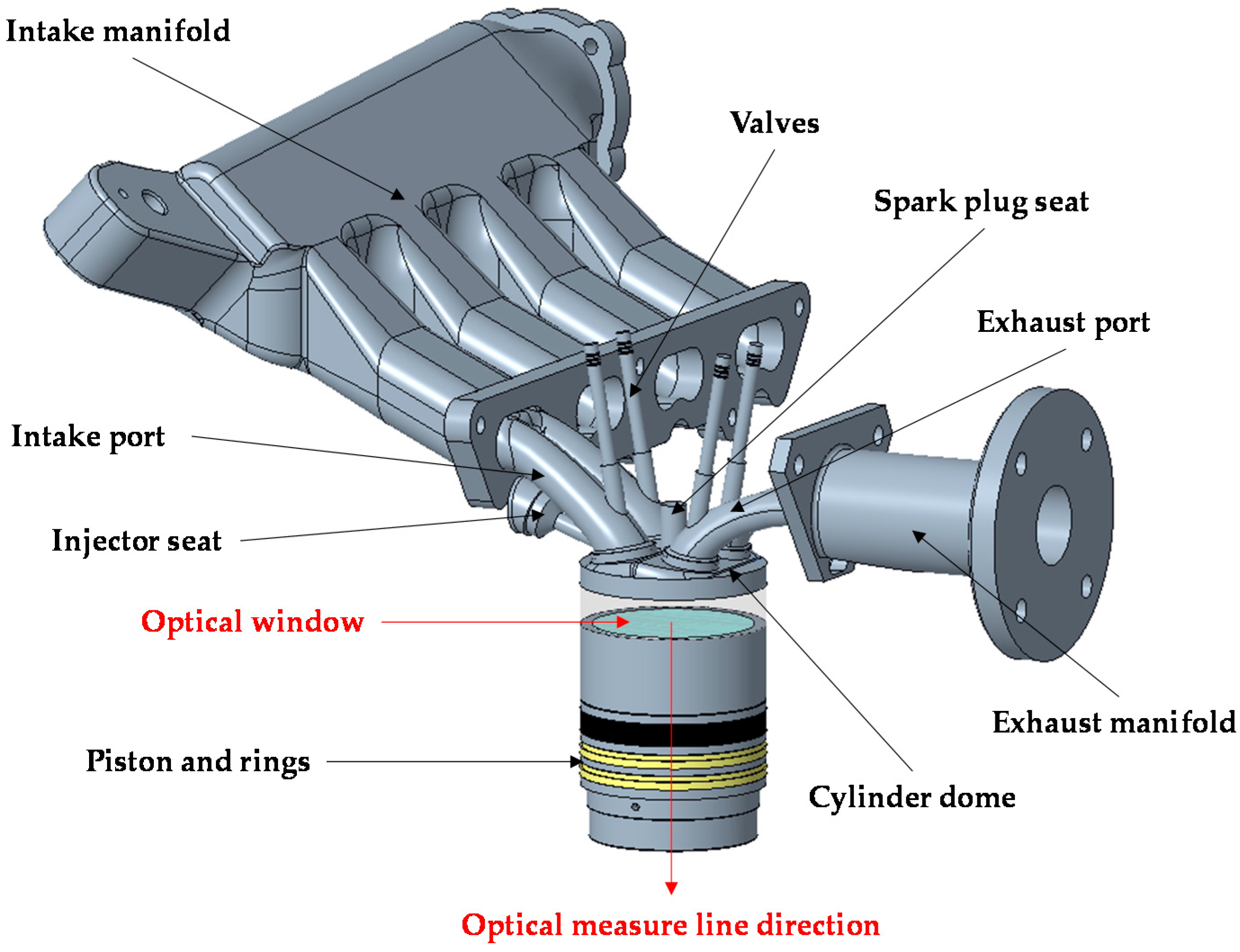
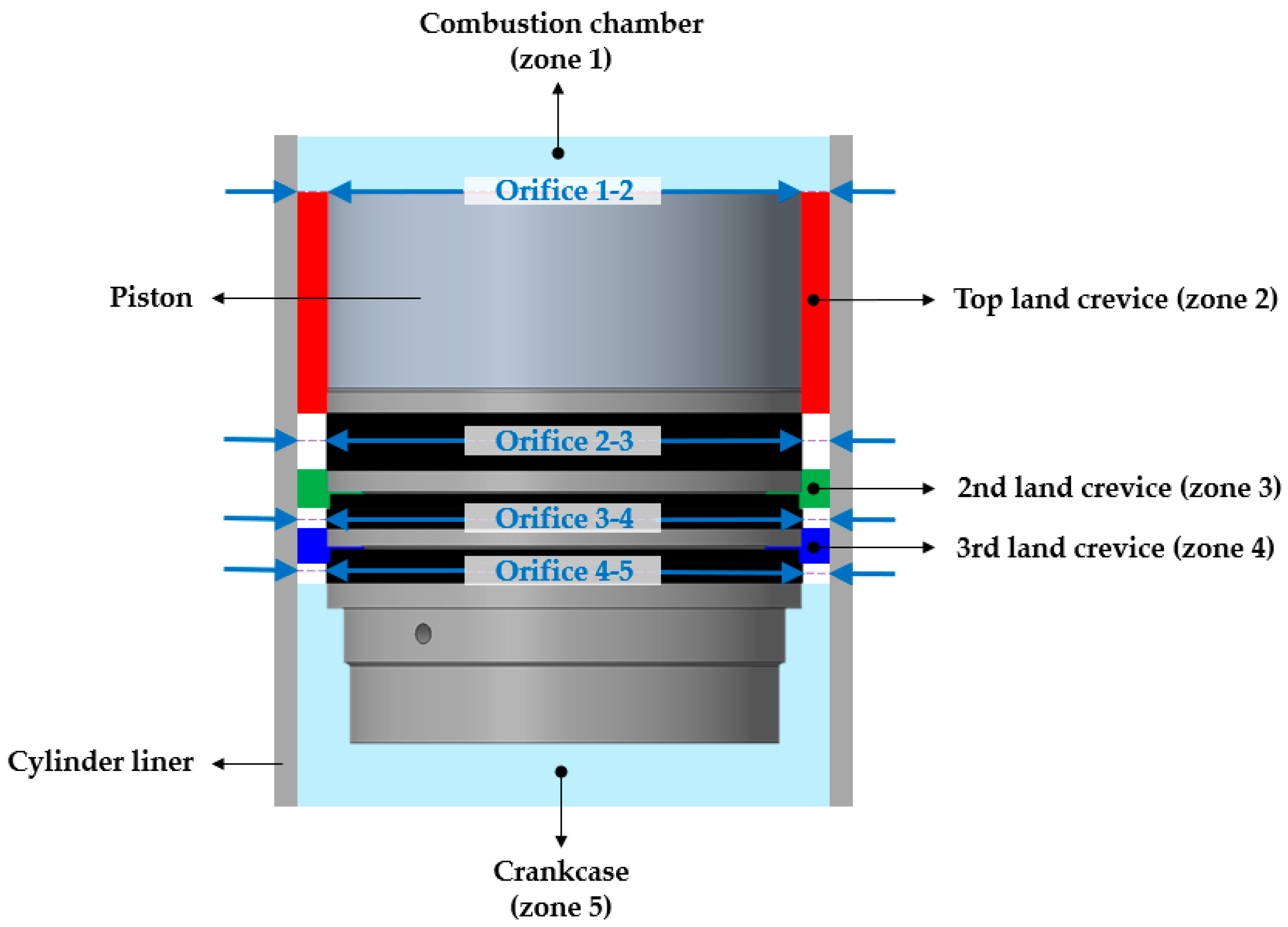

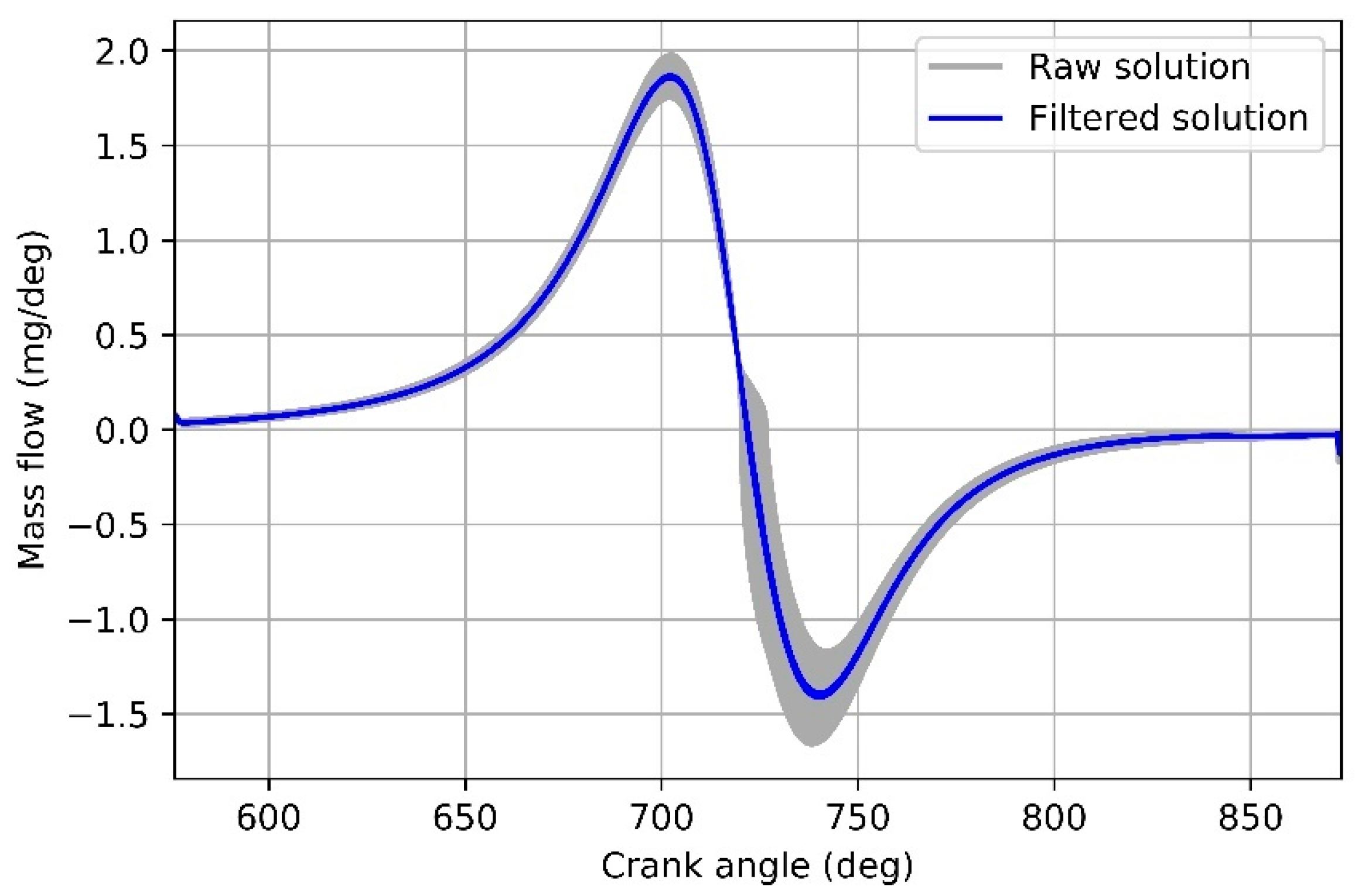





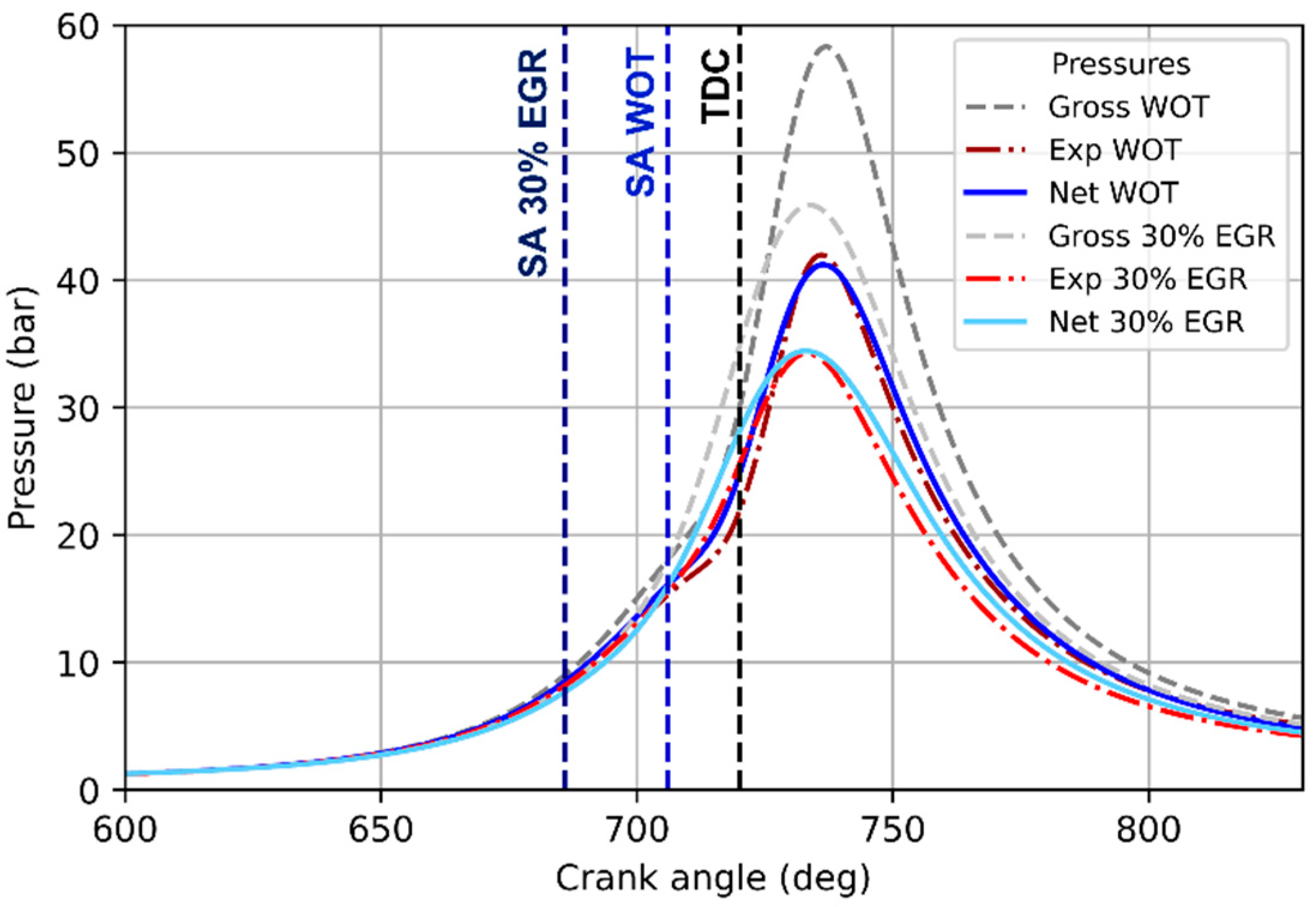

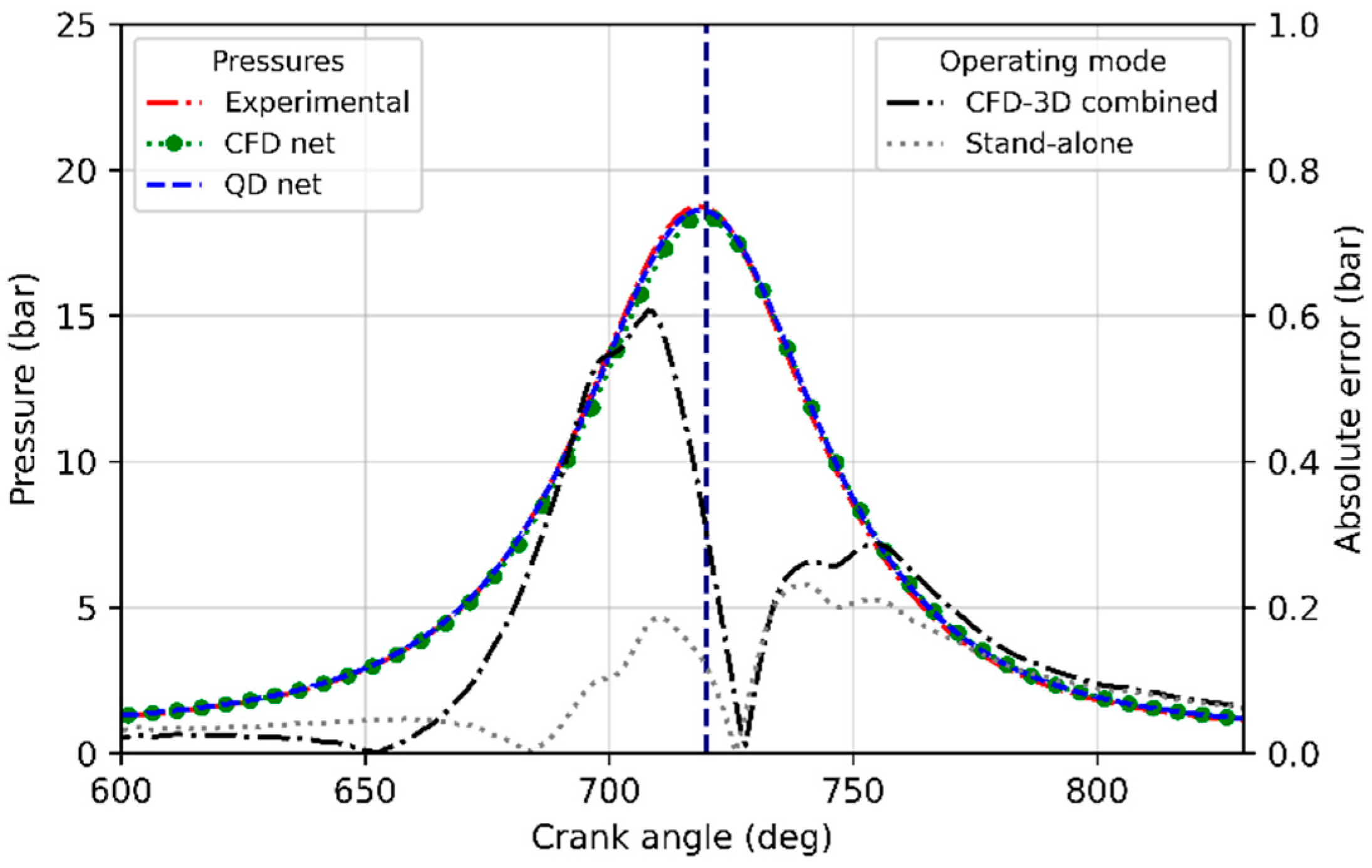
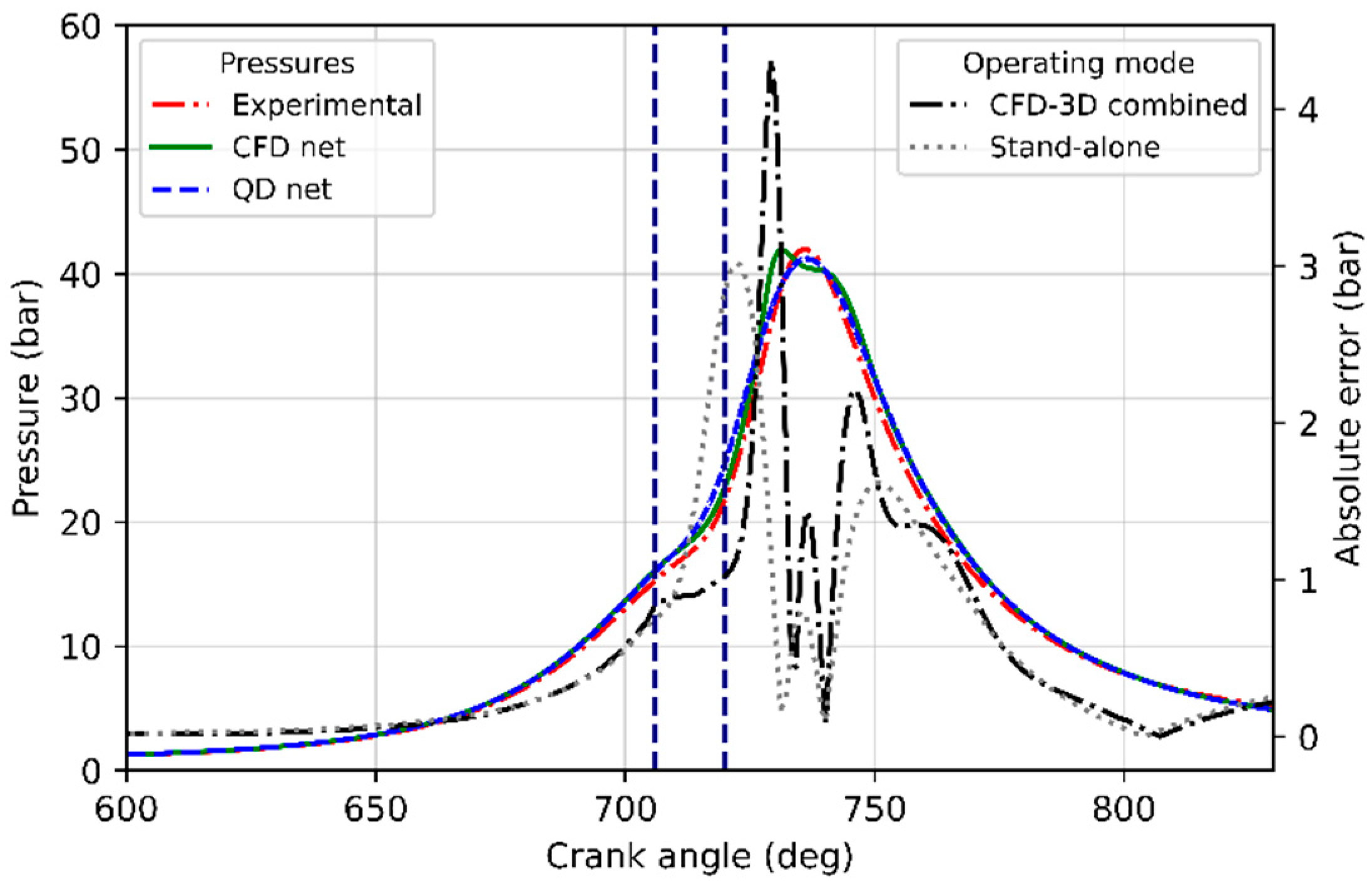
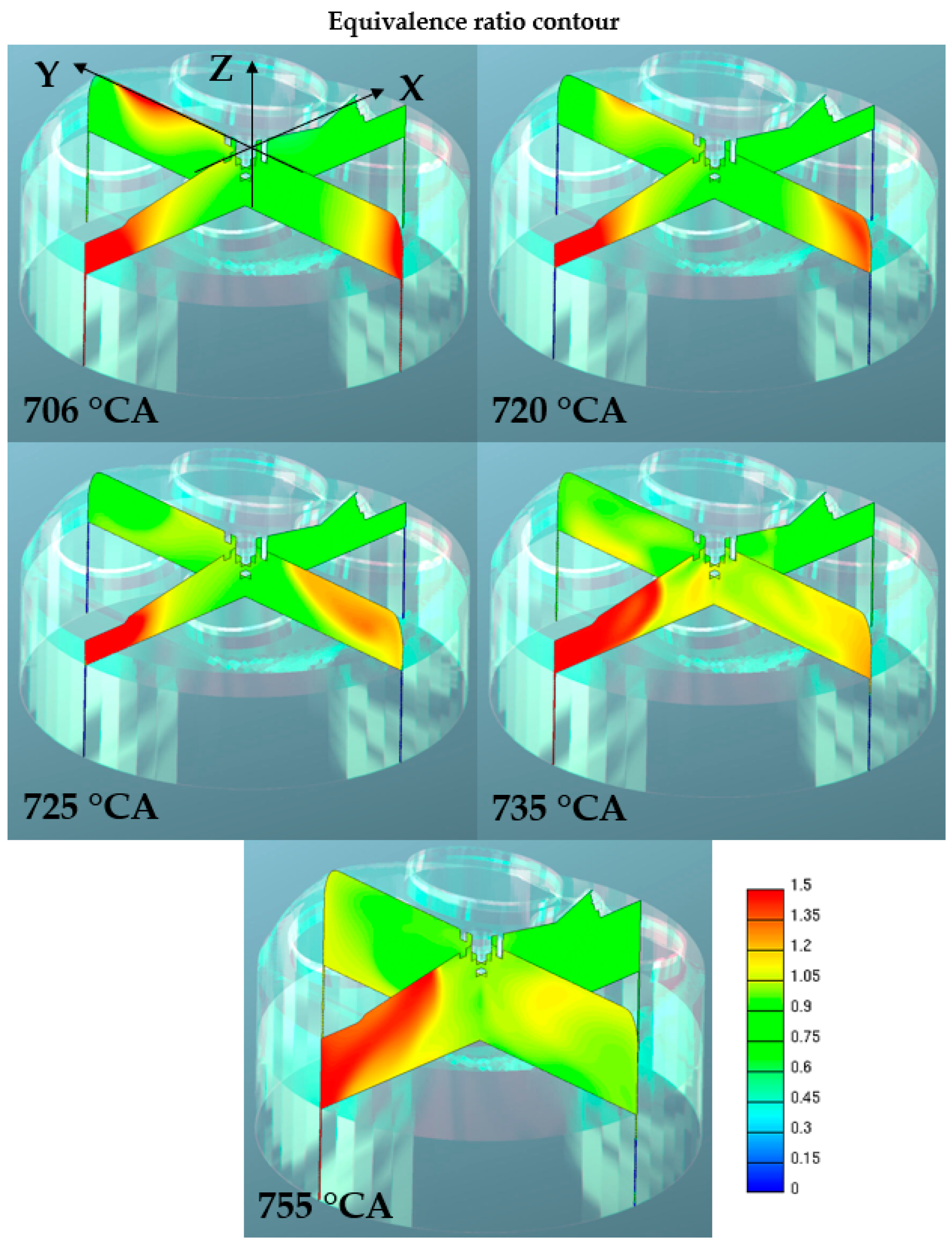
| Experimental Test Bench Engine Data | |
|---|---|
| Bore (mm) | 79.0 |
| Stroke (mm) | 81.3 |
| Conrod length (mm) | 143 |
| Geometric compression ratio | 10.0 |
| Number of valves | 4 |
| Intake valves opening/closure (°CA) | 363/576 |
| Exhaust valves opening/closure (°CA) | 207/360 |
| Engine speed (r/min) | 2000 |
| Fuel system | 100 bar DI wide spacing |
| Fuel | Commercial gasoline |
| SOI/EOI (°CA) | 430/469 |
| Engine load | Motored/Full load |
| Motored/Firing piston temperature (K) | 380/540 |
| Spark timing (°CA) | 706 |
| Crevice Volume Data (mm3) | ||
|---|---|---|
| Geometry | Reference Optical Engine | Commercial Typical [8] |
| Top land | 3468.4 | ≈970 |
| Second land | 654.7 | ≈353 |
| Third land | 654.7 | ≈353 |
| Ring Cross Section Area Data (mm2) | ||
| Cylinder-piston crown clearance | 74.2 | ≈62.60 |
| First ring | 12.4 | - |
| Second ring | 2.5 | ≈0.95 |
| Third ring | 2.5 | ≈0.95 |
| Orifice ID | ||
|---|---|---|
| 1 -> 2 | 0.6 | 0.85 |
| 2 -> 3 | 0.6 | 0.85 |
| 3 -> 4 | 0.6 | 0.7 |
| 4 -> 5 | 0.6 | 0.7 |
| Simulation Parameters | Setup |
|---|---|
| Code | AVL-FIRE commercial |
| N. of cells | 1.5M (BDC), 1M (TDC) |
| Base cell size | 1.0 mm |
| Spark plug cell size | 0.25 mm |
| Injector zone cell size | 0.5 mm |
| Blow-by cell size | 0.125 mm |
| Turbulence model | RANS k-z-f |
| Spray break-up model | Bianchi [28] tuned |
| Wall impingement model | Kuhnke |
| Combustion model | ECFM-3Z tuned |
| Ignition + laminar flame speed | Custom [29] |
| Blow-by boundary temperature | Piston temperature |
Publisher’s Note: MDPI stays neutral with regard to jurisdictional claims in published maps and institutional affiliations. |
© 2021 by the authors. Licensee MDPI, Basel, Switzerland. This article is an open access article distributed under the terms and conditions of the Creative Commons Attribution (CC BY) license (https://creativecommons.org/licenses/by/4.0/).
Share and Cite
De Renzis, E.; Mariani, V.; Bianchi, G.M.; Cazzoli, G.; Falfari, S.; Antetomaso, C.; Irimescu, A. Implementation of a Multi-Zone Numerical Blow-by Model and Its Integration with CFD Simulations for Estimating Collateral Mass and Heat Fluxes in Optical Engines. Energies 2021, 14, 8566. https://doi.org/10.3390/en14248566
De Renzis E, Mariani V, Bianchi GM, Cazzoli G, Falfari S, Antetomaso C, Irimescu A. Implementation of a Multi-Zone Numerical Blow-by Model and Its Integration with CFD Simulations for Estimating Collateral Mass and Heat Fluxes in Optical Engines. Energies. 2021; 14(24):8566. https://doi.org/10.3390/en14248566
Chicago/Turabian StyleDe Renzis, Edoardo, Valerio Mariani, Gian Marco Bianchi, Giulio Cazzoli, Stefania Falfari, Christian Antetomaso, and Adrian Irimescu. 2021. "Implementation of a Multi-Zone Numerical Blow-by Model and Its Integration with CFD Simulations for Estimating Collateral Mass and Heat Fluxes in Optical Engines" Energies 14, no. 24: 8566. https://doi.org/10.3390/en14248566
APA StyleDe Renzis, E., Mariani, V., Bianchi, G. M., Cazzoli, G., Falfari, S., Antetomaso, C., & Irimescu, A. (2021). Implementation of a Multi-Zone Numerical Blow-by Model and Its Integration with CFD Simulations for Estimating Collateral Mass and Heat Fluxes in Optical Engines. Energies, 14(24), 8566. https://doi.org/10.3390/en14248566







